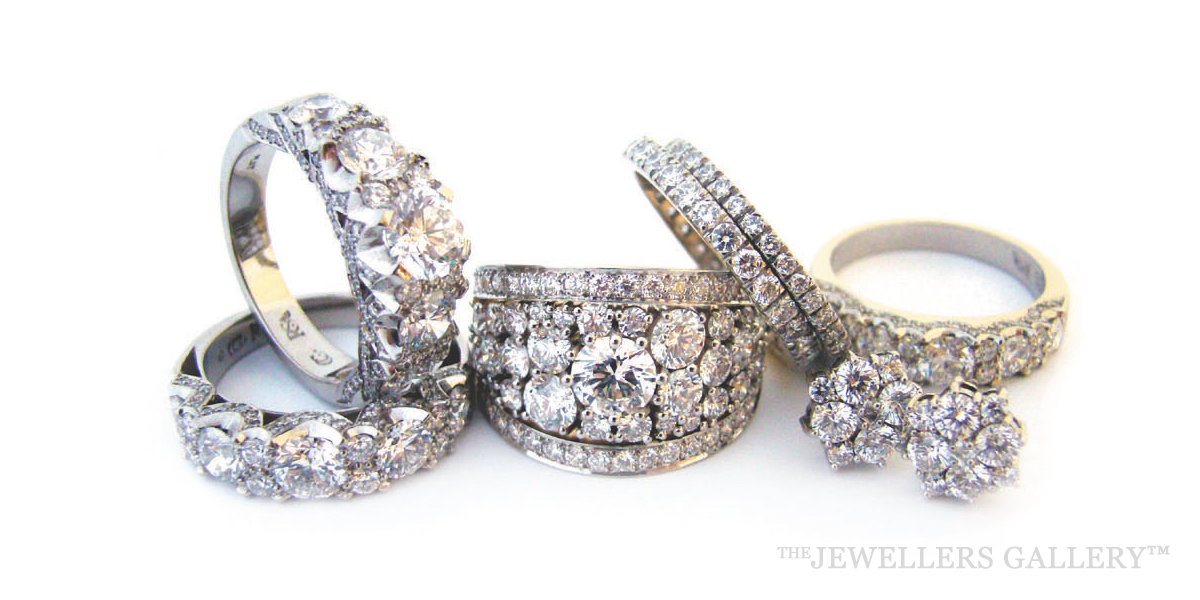6 of The Jewellers Gallery Handmade Rings and a pair of production casting earrings (front right)
THE MAKING OF OUR JEWELLERY
There are three basic types of Jewellery made in the world: Handmade, through production casting, and CAD (Computer Animated Design).
Handmade Jewellery
Starting with an ingot of the desired metal, the piece of jewellery is formed and assembled entirely by hand. This means each is a one-off piece and as such range from 40 -150 hours to design and create. 98-99%% of what you see here at The Jewellers Gallery is handmade. It allows us to create the unique quality of finishing and design that we value.
Production casting
A master pattern is made (always by hand here, sometimes in other places) which is then moulded. The mould is then injected with wax so that it may be cast using the lost wax method. This produces multiples of the same piece. Some manufacturers make thousands of units from one pattern. Here at The Jewellers Gallery you’ll find around 1-2% of our pieces are production castings, each from a finely designed and handmade master pattern and then hand finished to the highest standard.
CAD (Computer-Aided Design)
Many companies take advantage of the technology that allows them to computer design and 3D print a master for casting. We find that CAD jewellery is unable to achieve the fine resolution and finishing that we value in each of our pieces. As such, there is no CAD jewellery to be here at The Jewellers Gallery. In the CAD process, a design is constructed on a computer in three dimensions. This design is then formed in wax (i.e. 3D printed) by a machine before casting. These designs can then be used to make multiple pieces or one-offs.
PRECIOUS METALS
Platinum (usually stamped PLAT 950, ie, 95% platinum) is our metal of preference because of its beautiful natural white colour, its workability and wearability. It is also tarnish free and hypoallergenic. In our experience, skin irritations do not occur.
18ct yellow gold (stamped 750, ie, 75% pure gold) is an alloy mixture of pure gold, and usually silver and copper. This is also a nice material to use and is well known.
18ct white gold (stamped 750, ie, 75% pure gold) is a tricky metal to work with for two reasons. First, because it is not white, most if not all white gold seen in the shop windows is plated with rhodium to make it appear white. However, this will wear off, often unevenly, exposing the raw colour underneath. This may range from a dull grey to a faint yellow. At this stage, it needs to be replated at some cost to restore its white look. Second, 18ct white gold is often alloyed with nickel and, as a result, some people have an allergic reaction. Despite these limitations it is a fair metal to make jewellery with. We think it is better for earrings and pendants where there is not a lot of heavy wear which may remove the plating.
Palladium (usually stamped PALL 950 or Pd950, ie, 95% palladium). Palladium is coming back into fashion again because of price. It also has the advantage of having a similar white colour to platinum, does not need plating and seems to be hypoallergenic. We are happy to discuss making jewellery in palladium for you but have found there are some practical limitations in using this material.
9ct yellow gold (usually stamped 375, ie, 37.5 % pure gold) is an alloy, with more copper than gold in the recipe. There is also silver and zinc in the mix. It is cheap compared to 18ct and reasonably workable but is not highly recommended by us.
9ct white gold (usually stamped 375, ie, 37.5 % pure gold). We have not seen an alloy of this metal that we would be willing to use.
PRECIOUS STONES
Diamonds
Diamonds are renowned for their beauty, which comes from their sharp visual brilliance and sparkle, to which cut, colour and clarity all contribute. Longevity also makes diamonds a popular choice of gem; the hardness of diamonds led to the coining of the advertising slogan "diamonds are forever". They can last for generations whereas softer stones cannot be used for continuous everyday wear because they scratch and chip if not worn with great care.
We use collection colour diamonds D-F with a VS clarity for the smaller stones. These are a cut of top quality and make many average stones look poor. For the larger stones, a balance may need to be found between your budget and desire for size while making sure that the cut is excellent so that a very pretty and attractive stone is selected. For more information on diamond grading, go to www.gia.edu, the website of the GIA (Gemological Institute of America), or www.quasardiamonds.com, the Quasar website.
Precious coloured stones
Sapphires and rubies are also sought after for their hardness although they are not as durable as diamonds. (Note: Emeralds are relatively soft.)
Semi-precious coloured stones
These stones are softer and can be of considerable value and beauty.
